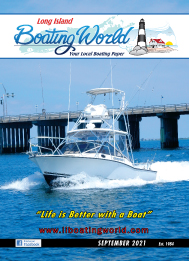
Aids to Navigation … Do Yellow Buoys Mark Yellow Submarines ??? Not really … but yellow buoys do exist. They are a part of the U.S. Aids to Navigation system which covers Near Coastal and Inland waters. It does not include the Western Rivers nor the Great Lakes. This system employs a wide variety of buoys, and a variety of day boards, rangers, and markers that are identified by their shape, color, numbers, letters, lights, and audible signals. These visual and audible devices identify navigable channels, and safe waters, They also alert navigators when obstructions are in near proximity to safe waters. In a way, navigation aids perform the same function as street lights, traffic lights, construction barriers, and safety cones. Perhaps the most readily identified aids to navigation are red nun buoys and green can buoys. Other examples are lighthouses, beacons, ranges and day boards. Some of these also feature lights, bells, gongs, and horn signals. When the elements of the Aids to Navigation system are combined they represent a comprehensive set of tools used to navigate safely through unfamiliar waters. Each aid has its purpose, which is to assist Skippers, Navigators, and Helmsmen determine the ship’s current location, and identify ways to keep it out of danger. It is important for every Skipper to be knowledgeable of charts and aids to navigation, and to make certain they keep abreast of any changes in the system. The Light List, Coastal Pilot, Charts and the Notice to Mariners are important publications that provide ongoing updates to the location and nature of navigational updates.
Charts … The U.S. aids to navigation are designed to complement charts. Together they form a reliable method for use when planning trips, and safely navigating the identified course. Charts also show the nature and shape of the coast, and the location of buoys, lighthouses, beacons, and water depths. They also provide the location of rocks, reefs. and wrecks. Lastly , charts include Longitude, Latitude, and both true and magnetic compass directions.
Buoys, Beacons, Ranges and Lights … All boaters are familiar with the red, even numbered Nun Buoys … and green odd numbered Can Buoys … However, many boaters are not familiar with the red / green horizontally colored Preferred Channel Buoys … When you come upon a preferred channel buoy with a red cone for a top mark, keep it on the starboard side. When you come upon a preferred channel buoy with a green top mark, keep it on the port side. Preferred Channel buoys are lettered and can be lighted with a light that corresponds with the top mark of the buoy. Isolated Danger Buoys … These are black and red horizontally striped buoys with two black balls as a top mark. They are lettered and can be lit with a white light with a flashing 2 rhythm. These buoys indicate a danger which may be encountered on all sides. They transmit a white morse code light to warn approaching ships. Safe Water Buoys … As their name suggests, these buoys mark safe waters on all sides of the buoy as you approach it. These may be lettered and colored red and white. Some are can shaped with a red ball on top. Safe water buoys can also be shaped as an octagon or a sphere. If lit, a safe water buoy will display a light that transmits morse code via a white light. Day Boards … These boards are diamond shaped and may be lettered. They are used to help the navigator find his or her ship’s location on a chart. When you see a day board and find the corresponding mark on the chart, you know your charted location. Day Boards may be lettered, and may be lighted with a white light. Their color reflects the red and green of nearby lateral buoys. Special Marks … These are lettered and colored yellow. Yellow navigation aids are located in the Intercoastal Waterway. They can be buoys, or daymarks. Markers can also be yellow triangles that indicate the aid should be kept to starboard. If square, these yellow shapes should be kept to port. Information and Regulatory Marks … Regulatory Marks re designed to assist boaters by informing them of special restrictions or dangers that they are approaching. Examples are, No Wake Zones, Swimming Areas, or a Speed limit. Regulatory marks are white can buoys that have an orange shapes with black lettering on them. The mark will give either a warning or instructions on
how to proceed. The shape determines what type of mark it is. An open diamond shape signifies danger … A diamond with a cross in it signifies an exclusion area that you may not enter … A circle indicates an upcoming operating restriction. A square or rectangular shape is used for conveying instructions. Obstruction Marks … These buoys are vertically marked with black and white strips. They are found in areas where obstructions exist between the buoy and the shore. The aids to navigation system is a sophisticated tool provided by the U.S. Coast Guard. The Western Rivers have a similar system managed by the Army Corps of Engineers … Smart Boating is Safe Boating !!!
